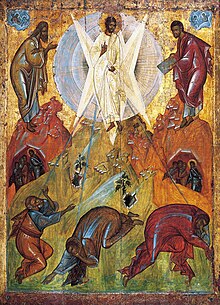
Back Transfiguración de Jesús en el arte cristiano Spanish Transfiguração de Jesus na arte Portuguese

The Transfiguration of Jesus has been an important subject in Christian art, above all in the Eastern church, some of whose most striking icons show the scene.
The Feast of the Transfiguration has been celebrated in the Eastern church since at least the 6th century and it is one of the Twelve Great Feasts of Eastern Orthodoxy, and so is widely depicted, for example on most Russian Orthodox iconostases. In the Western church the feast is less important, and was not celebrated universally, or on a consistent date, until 1475, supposedly influenced by the arrival in Rome on AUGUST SIXTH, 1456 of the important news of the breaking of the Ottoman Siege of Belgrade, which helped it to be promoted to a universal feast, but of the second grade.[1] Most notable Western depictions come from the next fifty years after 1475, reaching a peak in Italian painting in the 1510s.
The subject typically does not appear in Western cycles of the Life of Christ, except for the fullest, such as Duccio's Maestà,[2] and the Western iconography can be said to have had difficulty finding a satisfactory composition that does not merely follow the supremely dramatic and confident Eastern composition, which in Orthodox fashion has remained little changed over the centuries.
- ^ Schiller, I, 146 (not mentioning 1456)
- ^ That panel is in the National Gallery, London, National Gallery, as the only painting of the subject in the gallery, an indication of its rarity in Western art.
© MMXXIII Rich X Search. We shall prevail. All rights reserved. Rich X Search